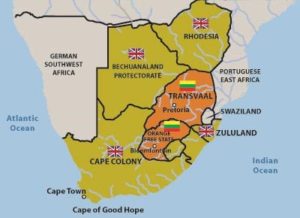The Anglo-Boer War in Southern Africa, beginning in 1899, was destined to become the first, but not by a long stretch the last, major military clash of the 20th century. The Boers were the descendants of German, French and Dutch settlers who had arrived in South Africa in the 1600s. Hard working Boers (‘Boer’ is the Dutch word for farmer) had developed the virgin land and built prosperous and free republics for themselves. But the discovery of gold and diamonds in the 1800s attracts the banksters’ interest and so of course that was all about to change.
Rothschild agent Cecil Rhodes, for whom ‘Rhodesia’ and the ‘Rhodes Scholarship’ would later be named and former rival, rags-to-riches millionaire Barney Barnato, joined forces and made the DeBeers company, the world’s largest diamond producer and consortium. Today it is owned by the Oppenheimer bankster family.
On 29th December 1895, a band of 500 British adventurers attempted to seize control of South Africa in an ‘unofficial’ armed takeover. The failed raid was led by Rhodes’ personal friend, Leander Starr Jameson. Undaunted by the raid’s failure, the UK-Jewish bankster alliance continued to foment war against the Boers, with Jewish newspapers in the UK being the most vocal of all. The Boers asked Britain to withdraw its troops, the Brits refused and so the Boer War began in earnest in October 1899.
The Rothschild-UK armies waged a brutal and cruel war, starving women and children in disease-ridden concentration camps and destroying farms. (Concentration camps were not invented by the Nazis.) These camps were originally designed for refugees whose farms had been destroyed by the brutal British ‘scorched earth’ policy (the burning-down of all Boer homesteads and farms.) Then, following Kitchener’s new policy, many women and children were forcibly moved to prevent the Boers from re-supplying from their homes and more camps were built and converted to prisons.
Neither was this the first instance of concentration camps, however. The Spanish had used them in the Ten Years’ War that later led to the Spanish-American War and the United States used them to devastate guerrilla forces during the Philippine-American War. But the concentration camp system of the British was on a much larger scale, there being a total of 45 tented camps built for Boer internees and 64 for black African ones. Of the 28,000 Boer men captured as prisoners of war, 25,630 were sent overseas. So, most Boers remaining in the local camps were women and children, but the native African ones held large numbers of men also.
The conditions in the camps were very unhealthy and the food rations were meagre and the wives and children of men who were still fighting were given smaller rations than others. The poor diet and inadequate hygiene led to endemic, contagious diseases such as measles, typhoid and dysentery. Coupled with a shortage of medical facilities, this led to large numbers of deaths.
A report after the war concluded that 27,927 Boers (of whom 22,074 were children under 16) and 14,154 black Africans had died of starvation, disease and exposure in the concentration camps. In all, about 25% of the Boer inmates and 12% of the black African ones died (although recent research suggests that the black African deaths were underestimated and may have actually been around 20,000).
When the British instigated and armed local black tribes to ‘kill the Boers’ (just as they had done with American Indian tribes against the rebellious American colonists of the 1770s,) the Boers finally submitted to British rule. This was yet another triumph for the banksters over a small self-sufficient, self-governing nation, now brought firmly under the banksters’ heel along with their multitude of natural resources, now fully ripe and ready to be turned into bankster profits.

